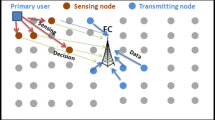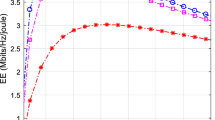Abstract
Cooperative spectrum sensing (CSS) that utilizes multi-user diversity to mitigate channel instability and noise uncertainty is a promising technique in cognitive radio networks (CRNs). However, the spectrum-sensing parameters which affect the channel-access opportunities of secondary users (SUs) are conventionally regarded as static and treated independently from the resource-allocation strategies. In this paper, joint optimization of CSS, channel access and resource allocation is investigated in an overlay CRN in which each SU carries multi-channel spectrum sensing and transmits the detected energy to a fusion centre in the imperfect reporting channel. An access factor is introduced to describe the channel-access strategies in both cooperative and non-cooperative schemes. Based on the aggregate interference and the transmit power constraints, an optimization problem of multi-channel CSS is formulated to obtain the optimal transmit powers, allocation-access strategies, and sensing threshold of CR system for maximization of the opportunistic throughput. To solve the non-convex problems in both the single and multiple CR systems, the efficient iterative algorithms are developed by exploiting the hidden convexity of the optimization problems. Numerical results show that the performance of our approaches yields a significant enhancement compared with the equal channel-access and equal power-allocation strategy.









Similar content being viewed by others
References
V. Asghari, S. Aissa, Adaptive rate and power transmission in spectrum-sharing systems. IEEE Trans. Wirel. Commun. 9(10), 3272–3280 (2010)
J. Bezdek, R. Hathaway, Some notes on alternating optimization, in Proceedings of 2002 advances in soft computing (2002), pp. 187–195
S. Boyd, L. Vandenberghe, Convex Optimization (Cambridge University Press, Cambridge, 2004)
A.S. Cacciapuoti, M. Caleffi, L. Paura, Widely linear cooperative spectrum sensing for cognitive radio networks, in 2010 IEEE global telecommunications conference (2010), pp. 1–5
R. Fan, H. Jiang, Optimal multi-channel cooperative sensing in cognitive radio networks. IEEE Trans. Wirel. Commun. 9(3), 1128–1138 (2010)
B.V. Gnedenko, A.N. Kolmogorov, K.L. Chung, J.L. Doob, Limit Distributions for Sums of Independent Random Variables (Addison-Wesley Press, Reading, 1968)
S. Haykin, Cognitive radio: brain-empowered wireless communications. IEEE J. Sel. Areas Commun. 23(2), 201–220 (2005)
E. Hossain, Cognitive Wireless Communication Networks (Springer, Berlin, 2009)
C. Jiang, R. Weng, Access control engine with dynamic priority resource allocation for cognitive radio networks. Wirel. Person. Commun. 68(2), 473–487 (2013)
G.P. Joshi, S.Y. Nam, S.W. Kim, Cognitive radio wireless sensor networks: applications, challenges and research trends. Sensors 13(9), 11196–11228 (2013)
X. Kang, Y. Liang, A. Nallanathan, H.K. Garg, R. Zhang, Optimal power allocation for fading channels in cognitive radio networks: Ergodic capacity and outage capacity. IEEE Trans. Wirel. Commun. 8(2), 940–950 (2009)
M. Lin, A.P. Vinod, A low complexity high resolution cooperative spectrum-sensing scheme for cognitive radios. Circuits Syst. Signal Process. 31(3), 1127–1145 (2012)
J. Ma, G. Zhao, Y. Li, Soft combination and detection for cooperative spectrum sensing in cognitive radio networks. IEEE Trans. Wirel. Commun. 7(11), 4502–4507 (2008)
H. Mu, J.K. Tugnait, Joint soft-decision cooperative spectrum sensing and power control in multiband cognitive radios. IEEE Trans. Signal Process. 60(10), 5334–5346 (2012)
M. Nguyen, H.S. Lee, Effective scheduling in infrastructure-based cognitive radio networks. IEEE Trans. Mob Comput. 10(6), 853–867 (2011)
J. Pang, G. Scutari, Joint sensing and power allocation in nonconvex cognitive radio games: Quasi-Nash equilibria. IEEE Trans. Signal Process. 61, 2366–2382 (2013)
Z. Quan, S. Cui, A.H. Sayed, Optimal linear cooperation for spectrum sensing in cognitive radio networks. IEEE J. Sel. Top. Signal Process. 2(1), 28–40 (2008)
C. Song, Q. Zhang, Cooperative spectrum sensing with multi-channel coordination in cognitive radio networks, in 2010 IEEE international conference on communications (2010), pp. 1–5
S. Srinivasa, S.A. Jafar, Soft sensing and optimal power control for cognitive radio. IEEE Trans. Wirel. Commun. 9(12), 3638–3649 (2010)
B. Wang, K. Liu, Advances in cognitive radio networks: a survey. IEEE J. Sel. Top. Signal Process. 5(1), 5–23 (2011)
X. Wang, Joint sensing-channel selection and power control for cognitive radios. IEEE Trans. Wirel. Commun. 10(3), 958–967 (2011)
E. Yaacoub, Z. Dawy, A survey on uplink resource allocation in OFDMA wireless networks. IEEE Commun. Surv. Tutor. 14(2), 322–337 (2012)
C. Yang, J. Li, Z. Tian, Optimal power control for cognitive radio networks under coupled interference constraints: a cooperative game-theoretic perspective. IEEE Trans. Veh. Technol. 59(4), 1696–1706 (2010)
H. Yu, W. Tang, S. Li, Optimization of cooperative spectrum sensing in multiple-channel cognitive radio networks, in Proceedings of IEEE global telecommunications (2011), pp. 1–5
R. Yu, Y. Zhang, L. Yi, S. Xie, L. Song, M. Guizani, Secondary users cooperation in cognitive radio networks: balancing sensing accuracy and efficiency. IEEE Wirel. Commun. 19(2), 30–37 (2012)
W. Zhang, R. Mallik, K. Letaief, Optimization of cooperative spectrum sensing with energy detection in cognitive radio networks. IEEE Trans. Wirel. Commun. 8(12), 5761–5766 (2009)
N. Zhao, F. Pu, X. Xu, N. Chen, Cosine-modulated transceivers for TV white space cognitive access. Chin. J. Electron. 21(2), 362–366 (2012)
N. Zhao, F. Pu, X. Xu, N. Chen, Optimisation of multi-channel cooperative sensing in cognitive radio networks. IET Commun. 7(12), 1177–1190 (2013)
Q. Zhao, B.M. Sadler, A survey of dynamic spectrum access. IEEE Signal Process. Mag. 24(3), 79–89 (2007)
Acknowledgments
This work was supported by National Natural Science Foundation of China (No. 61501178), Natural Science Foundation of Hubei Province (No. 2015CFB646), Open Foundation of Hubei Collaborative Innovation Center for High-efficient Utilization of Solar Energy (No. HBSKFMS2014033), Ph.D. Research Startup Foundation of Hubei University of Technology (No. BSQD13029). The author would like to acknowledge the anonymous reviewers whose constructive criticism, comments, and suggestions led to a greatly improved manuscript.
Author information
Authors and Affiliations
Corresponding author
Appendix
Appendix
1.1 Proof of Lemma 1
Part (a) can be easily shown by using \(\rho _k =1\) and \(p_k = P_\mathrm{tot}\), to maximize Problem P2. We note that this upper bound is not achievable but can be used to show the convergence of the algorithm to a fixed point.
Next, we prove part (b) by contradiction. We first assume \(R(\varvec{p^{(j)} },\varvec{\rho ^{(j)} }) > R(\varvec{p^{(j)} },\varvec{\rho ^{(j+1)} })\). This means that in Step 3 of Algorithm 1, the objective function decreases. However, this is not possible since the subproblem is convex and \(\varvec{\rho ^{(j+1)} }\) is a feasible point and cannot have a smaller objective function than \(\varvec{\rho ^{(j)} }\). Thus, we have \(R(\varvec{p^{(j)} },\varvec{\rho ^{(j)} }) \le R(\varvec{p^{(j)} },\varvec{\rho ^{(j+1)} })\). Using the same argument, it can also be shown that \(R(\varvec{p^{(j)} },\varvec{\rho ^{(j+1)} }) \le R(\varvec{p^{(j+1)} },\varvec{\rho ^{(j+1)} })\). Consequently, the objective function is non-decreasing in j, i.e., \(R(\varvec{p^{(j)} },\varvec{\rho ^{(j)} }) \le R(\varvec{p^{(j)} },\varvec{\rho ^{(j+1)} }) \le R(\varvec{p^{(j+1)} },\varvec{\rho ^{(j+1)} })\).
The third part (c) follows directly from part (a) and part (b), since any upper bounded, non-decreasing function converges to a fixed value.
Rights and permissions
About this article
Cite this article
Zhao, N. Joint Optimization of Cooperative Spectrum Sensing and Resource Allocation in Multi-channel Cognitive Radio Sensor Networks. Circuits Syst Signal Process 35, 2563–2583 (2016). https://doi.org/10.1007/s00034-015-0163-9
Received:
Revised:
Accepted:
Published:
Issue Date:
DOI: https://doi.org/10.1007/s00034-015-0163-9




